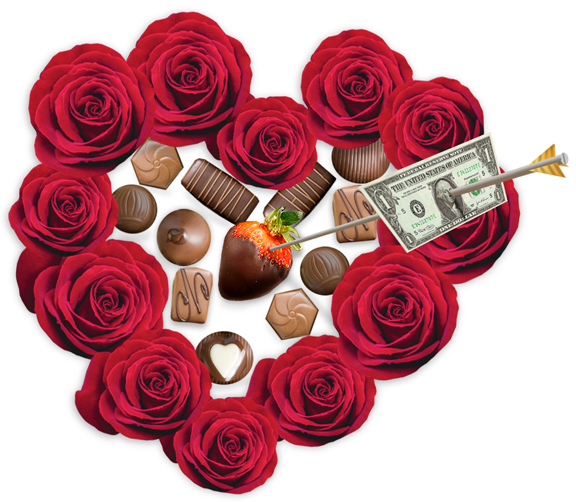 Today is Valentine’s Day, a day devoted to the expression of
love! And a day that will cost you top dollar to express your love in tangible
ways, namely: roses, candy, greeting cards, dinners at expensive restaurants,
diamond jewelry, etc. Anything with a heart or a chubby flying baby on it will
come at a price! How did we get to the place that we will pay any amount of
money to buy trinkets of our affection by the end of the day? The answer is
love! We will do anything for love! Marc Antony gave up Rome for the love of
Cleopatra. Paris and Helen started a war between Sparta and Troy over love. And
what about Romeo and Juliet, Scarlett O’Hara and Rhett
Butler, Bonnie and Clyde, Desi and Lucy, Meghan Markle and
Prince Harry?
Today is Valentine’s Day, a day devoted to the expression of
love! And a day that will cost you top dollar to express your love in tangible
ways, namely: roses, candy, greeting cards, dinners at expensive restaurants,
diamond jewelry, etc. Anything with a heart or a chubby flying baby on it will
come at a price! How did we get to the place that we will pay any amount of
money to buy trinkets of our affection by the end of the day? The answer is
love! We will do anything for love! Marc Antony gave up Rome for the love of
Cleopatra. Paris and Helen started a war between Sparta and Troy over love. And
what about Romeo and Juliet, Scarlett O’Hara and Rhett
Butler, Bonnie and Clyde, Desi and Lucy, Meghan Markle and
Prince Harry?
If Valentine’s Day is a brand, it has three components to it
that make it a surety to sell. Anyone in
marketing should take notice of these three elements and incorporate them into
your own brand marketing.
Emotion sells
Any time we can connect emotion with a brand, it enhances
the salability of the product or service. That can be an emotion connected with
happiness or joy, which is why chocolate sells so well on Valentine’s Day. It
can also be connected with negative emotions, such as anger or fear (think
about political campaigns). If your brand evokes emotion, it stands a good
chance of selling. How do you get an emotion attached to what you are selling?
It is the job of marketing to define your brand for the customer. The words and
images you use to define your brand should be selected carefully. Here are a
couple of examples from Duracell and Extra Chewing Gum.
The deadline is
imminent
Emotion sells, but it sells better with a time limit. February
14 comes around every year, yet very few people (especially men) were thinking
about buying flowers one month earlier on January 14. Valentine’s Day creates a
very firm deadline for consumers who will procrastinate making a purchase until
the day of the event (which is why something that is perishable, like roses,
sell so well on this day.) When you can build a cut-off date in your marketing
along with an emotional reason to buy, you can create a marketing frenzy around
your brand. Roses must be purchased and delivered by February 14 – no later! No
one wants to receive flowers on February 15 – the day after the deadline. In
fact, doing so would indicate that the person giving the flowers was something
of a careless ogre instead of the love of your life. When you build an imminent
deadline, you create a run on your brand.
Tell your story
Emotion also sells when you have a good story behind it. And
stories are legendary on a day like Valentine’s Day. You might know the history
of St. Valentine’s Day goes all the way back to February 14, 278 A.D. That is
the day a priest named Valentine was executed. As the legend goes, the Roman Emperor Claudius II decided
to forbid all marriages because he was having trouble getting men to leave
their wives and families to go off to war. No more love, by decree of Rome! Valentine
was a priest who continued to perform wedding ceremonies on the sly. In time,
Valentine’s wedding ceremonies were found out by the authorities and he was
sentenced to be executed. While he was in jail, Valentine became acquainted
with the jailer's daughter. On the day of the execution, he wrote her a
farewell note and signed it "From Your Valentine." Thus came a legend
that the gift card industry seized upon to create a great demand for their
products. They had all three elements of effective branding: emotion, a
deadline, and a story that pulls at your heart. Hallmark began producing
Valentine’s Day cards in 1913. It was so effective that they began to mass
produce cards in 1916. By marketing the need to express affection on this day,
they now sell over 1 billion Valentine’s greeting cards in the U.S.
If
you want to be effective in your marketing efforts, take a lesson from the
marketing of Valentine’s Day. Build emotion into the marketing of your brand.
Create a deadline in your marketing campaign that benefits the customer if they
purchase before the time limit and is at a disadvantage if they buy afterwards.
Couple those two tasks with a great story behind your brand and you will have
the marketing triangle working for you.